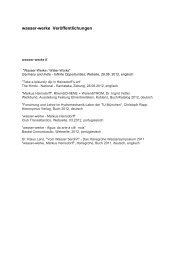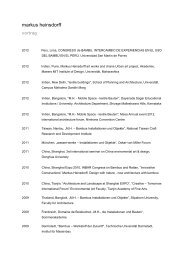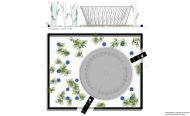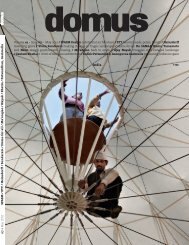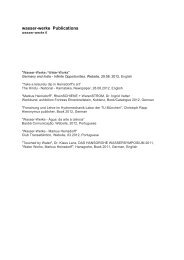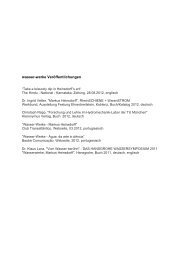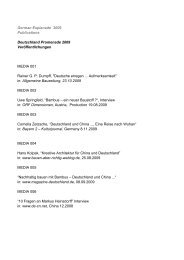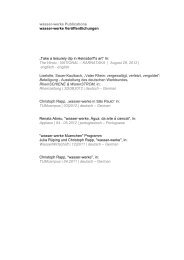Detail Magazin | Serie 2013 1/2 Transparent und - Heinsdorff, Markus
Detail Magazin | Serie 2013 1/2 Transparent und - Heinsdorff, Markus
Detail Magazin | Serie 2013 1/2 Transparent und - Heinsdorff, Markus
Sie wollen auch ein ePaper? Erhöhen Sie die Reichweite Ihrer Titel.
YUMPU macht aus Druck-PDFs automatisch weboptimierte ePaper, die Google liebt.
10<br />
12 Leuchtende Edelsteine für Indien – ein Interview mit <strong>Markus</strong> <strong>Heinsdorff</strong> <strong>2013</strong> ¥ 1/2 ∂<br />
We decided that, to avoid wasteful intercontinental<br />
transport, all components of the pavilions<br />
would be produced in India. Then we<br />
went to work to develop a structure that<br />
would require the least possible mechanical<br />
cooling. That is why we developed types, for<br />
example, whose double skins keep the air<br />
moving continuously – a principle used in<br />
traditional dwellings. The outer skin of one<br />
type is woven, and in this manner, a variety<br />
of openings are created that, for example,<br />
ventilate the pavilion and provide shade. We<br />
tested this type in advance – as our construction<br />
office. We had no air conditioning, just<br />
two fans, and were able to keep cool at 40°<br />
to 45° C.<br />
The membrane used for the outer skin is<br />
made of PVC. How can that be reconciled<br />
with sustainable building methods?<br />
Our concept foresaw, of course, the use of<br />
natural materials. And, needless to say, there<br />
are fabulous products available. But the costs<br />
were prohibitive. Our choices became even<br />
more limited because we needed a relatively<br />
small amount of material, and by our desire to<br />
use material made within the country’s borders.<br />
Fireresistance standards also had to be<br />
met – and, by the way, we were <strong>und</strong>er obligation<br />
to heed both the Indian and the German<br />
building codes. So, in the end, PVC was the<br />
only option for the outer skin. The good thing<br />
about the material is that it can be employed<br />
11 12<br />
well in India. And it has withstood the strains<br />
of transport between the different locations<br />
surprisingly well – on flatbed trucks that have<br />
passed through sandstorms and monsoons.<br />
But their durability after the event is also very<br />
important to me. The intention is that they be<br />
installed somewhere permanently, for example<br />
at a university, or as a display pavilion. The<br />
Chinese pavilions have, for example, fo<strong>und</strong> a<br />
new home in France.<br />
The membrane you used is, to a certain degree,<br />
permeable to light. What role does<br />
translucence play in the pavilions?<br />
First of all, with these mobile structures I hope<br />
to call attention to principles of environmentally<br />
so<strong>und</strong> construction methods. We used<br />
membranes with 10% permeability. This material<br />
has the advantage that the interiors,<br />
which are used for exhibitions, conferences,<br />
presentations, and other events, require no<br />
electric lighting during the day. But the atmosphere<br />
is also much better than in standard<br />
tent structures encountered in Asia, which are<br />
typically impervious to light and are, generally<br />
speaking, spaces in which one does not feel<br />
at ease. The translucence gives the space a<br />
warmtoned light – an effect that is reinforced<br />
by our choice of an offwhite inner membrane.<br />
And the play of shadows in the doubleskin<br />
pavilions is incredibly alluring. This was also<br />
the case in our earlier bamboo structures as<br />
well: I worked with metal mesh and, by over<br />
10 »German beer garden« auf der »Urban Mela«<br />
in Delhi, November 2012<br />
11 Pavillons Typ 2 <strong>und</strong> 3<br />
12 <strong>Markus</strong> <strong>Heinsdorff</strong> im Gespräch mit Ausstellungsbesuchern<br />
10 The German Beer Garden at the Urban Mela in<br />
Delhi, November 2010<br />
11 Pavilion types 2 and 3<br />
12 <strong>Markus</strong> <strong>Heinsdorff</strong> talking with visitors to the<br />
exhibition<br />
Das Interview führte Christian Schittich in Delhi.<br />
Christian Schittich conducted the interview in Delhi.<br />
lapping it, achieved silky effects. But the trees<br />
also cast shadows on the membrane and at<br />
times create a spectacle that is reminiscent of<br />
Japanese inkwash painting.<br />
And seen from outside...<br />
...there is the daytime look and the nighttime<br />
look. I am, by training, a sculptor. For this reason,<br />
the play of light and shadow over the<br />
course of a day is very important to me. Consequently,<br />
the outer envelope is articulated<br />
threedimensionally: the surfaces are animated<br />
regardless of the colour that has been employed.<br />
At night, in contrast, they glow like<br />
lampions, which have a long tradition in India.<br />
To what extent can these wandering pavilions<br />
serve as a model for these principles?<br />
Of course I would like to encourage the use of<br />
textiles in buildings, because India has a long<br />
tradition of this, although there is not much<br />
evidence of it in today’s cities. There are, as I<br />
mentioned, the wedding tents, but these are<br />
standardised, and there is no further development<br />
of them. The growing population, however,<br />
is creating a need for flexible housing.<br />
Some commuters spend up to five hours a<br />
day on the train; others build temporary housing<br />
from discarded material – a phenomenon<br />
involving recycling, not to be confused with<br />
slum building – and reside there a few weeks<br />
before returning to their permanent homes.<br />
The idea of being able to transport a house on<br />
my back – but in a different sense from camping<br />
– inspires me to develop flexible systems,<br />
ideally using natural materials. Bamboo is predestined<br />
for such applications. It grows<br />
aro<strong>und</strong> the globe in a specific climate zone<br />
and is usually accessible to the general public,<br />
particularly so in India. It can be harvested after<br />
just three years, for example following<br />
earthquakes or flooding – which are frequent<br />
occurrences in India. On the other hand, a<br />
membrane produced with the simplest of<br />
means is ideal. But the people of India – and<br />
elsewhere in Asia, as well – tend to look down<br />
on bamboo and textiles in buildings. I hope to<br />
turn these attitudes aro<strong>und</strong> by developing a<br />
hightech structure that brings to mind a small<br />
spacecraft that has just landed on Earth.



